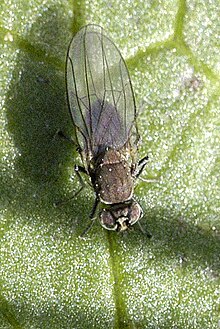This article includes a list of general references, but it lacks sufficient corresponding inline citations .(January 2025) |
| Ephydridae | |
|---|---|
 | |
| Hydrellia griseola | |
| Scientific classification | |
| Domain: | Eukaryota |
| Kingdom: | Animalia |
| Phylum: | Arthropoda |
| Class: | Insecta |
| Order: | Diptera |
| Superfamily: | Ephydroidea |
| Family: | Ephydridae Zetterstedt, 1837 |
| Subfamilies and tribes [1] | |
| |
Ephydridae (shore fly, sometimes brine fly) is a family of insects in the order Diptera.
Contents
- Description
- Larvae
- Identification
- Habitats
- Species lists
- See also
- Phylogeny
- References
- External links
Shore flies are tiny flies that can be found near seashores or at smaller inland waters, such as ponds. About 2,000 species have been described worldwide, [2] including Ochthera.
The petroleum fly, Helaeomyia petrolei, is the only known insect whose larvae live in naturally occurring crude petroleum. Another notable species is Ephydra hians which lives in vast number at Mono Lake.

